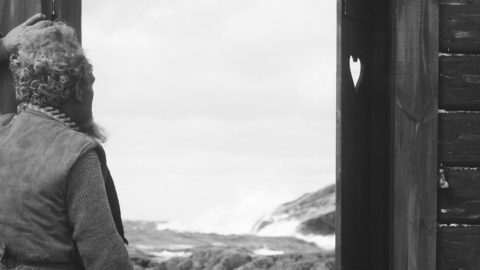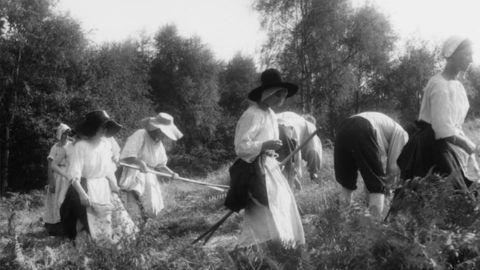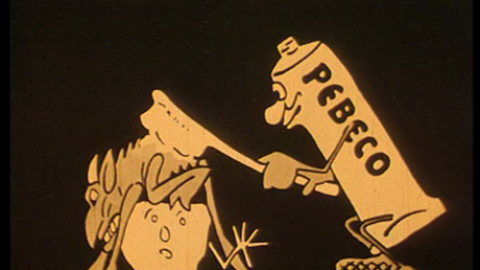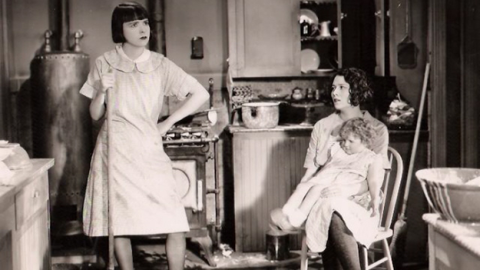Festivals: Pordenone 2018
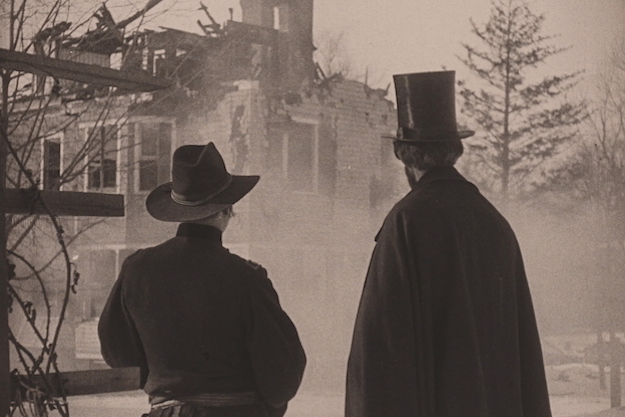
From The Lincoln Cycle
Now in its 37th year, Le Giornate del Cinema Muto, the Pordenone Silent Film Festival, has turned a town in northern Italy into a site of pilgrimage for fans and scholars of early cinema from around the world. For a week in early October this year, Pola Negri’s face was plastered all over town, long queues snaked through the central piazza before a screening of Lubitsch’s Forbidden Paradise (1924), and you couldn’t grab a gelato or a glass of wine without hearing snatches of conversations about camera negatives and wet-gate scanning. The intensive immersion in silent movies provided by the Giornate—eight days of almost nonstop screenings, focusing on restorations and rediscoveries as well as reconsiderations of the canon—has the effect of condensing the roughly three decades of the silent era and distilling its essence. You can see elements of film grammar and style—flashbacks, for instance, or intercutting—emerge and blossom, like watching a time-lapse record of a flower blooming.
A centerpiece of the 2018 festival was a near-complete retrospective of the surviving silent films of John M. Stahl, starting with the Lincoln Cycle (1917), a series of 10 short films produced by Benjamin Chapin as a vehicle for his performance as Abraham Lincoln. (Stahl received no on-screen credit from the egotistical Chapin, but credibly claimed throughout his career that he was the director.) Structured entirely around memory and recollections of the past, these surprisingly sophisticated small dramas, eight of which survive, include flashbacks that recur with variations or changes in point of view, and even flashbacks-within-flashbacks. In Tender Memories, President Lincoln visits the front lines, evoked with bleak landscapes of stubbly corn fields and snowy banks strewn with the bodies of fallen soldiers. Watching a man lash two sticks together to make a cross marking the grave of his friend prompts Lincoln to recall his mother’s death and her unmarked grave in the forest. The scenes of young Abe (the excellent child actor Charlie Jackson) in the leafless woods at twilight convey a mood of inconsolable grief, and when his mother fleetingly materializes at the foot of a tree where she used to read to him, the vision is not sentimental but piercing.
A similar moment occurs in John Collins’s short The Portrait in the Attic (1914), when a young girl (Viola Dana) falls asleep cradling a painting of her dead mother and dreams her back to life through a simple but oddly moving camera trick. There is a freshness and gravity in these early uses of optical effects to represent imagination and memory, even as you can see innovations becoming conventions year by year. Collins, a director at the Edison studio whose promising career was cut short when he died in the 1918 flu pandemic, was the subject of another thread at the festival, with new restorations presented by the Museum of Modern Art. In Collins’s charming films, which range from one to three reels, you can watch someone figuring out—in real time, as it were—how to tell a story with the camera. (Just in case, intertitles explain what’s going to happen in advance.) The Slavey Student (1915) has a delightful, Busby Berkeley–esque moment of fantasy when, after a high school dance, we see a row of sleeping schoolgirls, their beds set in a diagonal across the frame; behind each bed, a young man materializes, and as the tuxedoed beaus fade away, the girls in unison turn over on their pillows, with a sigh that is seen, not heard.
A mere six years later, Victor Sjöstrom’s masterpiece The Phantom Carriage (1921) makes extensive use of ghostly double exposure, overlaying the wraiths of the dead on the world of the living. The story of a man forced to confront his evil life on the threshold of death is told through a complex structure of shifting viewpoints and non-chronological flashbacks, but with stark and devastating emotional force. Jean Epstein plays masterfully with time in L’Auberge Rouge (1923), which translates a Balzac tale—framed as a lurid crime story told at a dinner party—into a liquid, febrile, yet formally precise play of images, cutting back and forth between past and present to create a rhythmic counterpoint.
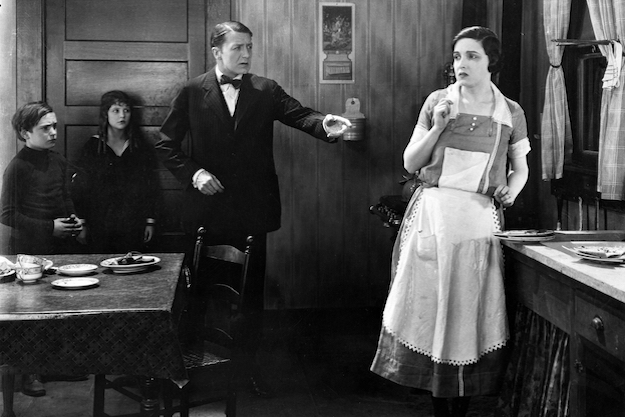
The Home Maker
One of the best Stahl films shown in Pordenone, Memory Lane (1926), uses neither flashbacks nor camera tricks to convey the pull of the past, relying instead on well-written, well-acted, behavior-driven scenes, with an assist from nostalgic music cues. Eleanor Boardman plays a woman torn between romantic attachment to her high school sweetheart (William Haines) and loyalty to her pallid but devoted husband (Conrad Nagel). Shifting easily between comic wit and bittersweet melancholy, the film illustrates Stahl’s arrival at his mature style, marked by deft use of detail, clear-eyed empathy for his characters, and graceful control of structure and tone. Emerging from long neglect and obscurity, Stahl’s silent films greatly strengthen the case for him as a distinctive stylist and a quietly radical voice. (The Call of the Heart: John M. Stahl and Hollywood Melodrama, a new collection of essays edited by Charles Barr and Bruce Babington, was released in conjunction with the retrospective at Pordenone.)
Stahl’s early melodramas and light comedies center on women’s dilemmas, illustrating the double standards and restrictions they struggled with, but these were not the only or the most bracingly feminist films on the program. That honor belonged to King Baggot’s The Home Maker (1925), a little-known drama championed by Kevin Brownlow, who selected it as one of six films screened in celebration of the 50th anniversary of his artful, idiosyncratic, endlessly rewarding history of Hollywood in the silent years, The Parade’s Gone By. While The Home Maker’s premise alone is remarkable—it follows a middle-class family whose lives are in every way improved after the husband is crippled and becomes a stay-at-home Dad while his wife takes on the role of breadwinner—the film’s triumph lies in its meticulously mundane and deeply felt portrait of domestic life, and in the intense yet understated performances by Alice Joyce and Clive Brook, as the couple—and of Billy Kent Schaeffer as one of cinema’s most realistically foul-tempered children.
The massive convulsions of World War I and the social and cultural revolutions of the 1920s are felt everywhere in silent movies, which are filled with sparks and tremors of newness, as people dance on the shifting, broken ground. It is not surprising that many films of the period feel conflicted, sometimes even muddled in their response to the changes, caught between challenging and appeasing tradition. In John Robertson’s Captain Salvation (1927), a gorgeous seafaring adventure with a strong moral underpinning, a rebellious seminary student (Lars Hanson) breaks with his stern father and dour New England community when he defends an injured prostitute (Pauline Starke). The fallen woman is allowed to voice her wounded rage at a world that both abuses and judges her, but in the end required to sacrifice herself, restoring her own purity and the hero’s faith.
The tension between tradition and modernity, repression and freedom, is explicit in many films, but it also seems inherent in an art form that drew on Victorian plot conventions, and even older folk stories, while constantly exploring the possibilities of a new and rapidly evolving technology. Universal themes and melodramatic formulas (for instance, authoritarian fathers who thwart their children’s desires) return again and again in widely different and richly specific settings—from the taxi-dance halls of Tokyo Ondo (1932) to the pure, wild sweep of northern woods in the Norwegian Troll-Elgen (The Ghost Elk, 1927), from which the hero is exiled—to a seedy urban carnival where he earns his living as a sharpshooter, billed as “the cowboy from Texas”—because of his forbidden love for a rich farmer’s daughter. E.A. Dupont’s The Ancient Law (1923) largely sides with its hero’s yearning to escape the narrow, insular life of the shtetl and become an actor, but treats the village and the rituals of Jewish life with respect and tenderness, even sympathizing with the rabbi’s anger and incomprehension at his son’s defection. The film summons a lost world of weathered wood cottages and dusty fields, traveling theater troupes and wandering beggars, the courts and theaters of Vienna, all in patient long takes. To see such intimate sympathy with Jews in a mainstream German film 10 years before Hitler came to power is in itself astonishing.
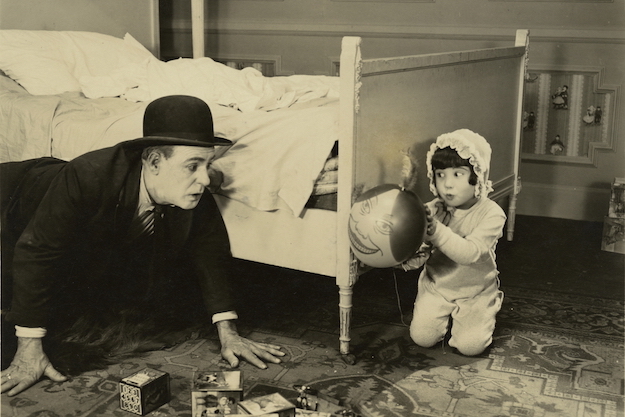
Our Pet
Also astounding—if occasionally exhausting—is the sheer scale and spectacle of some films in the days before sound tethered movies to studios. Mario Bonnard and Nunzio Malasomma’s German-produced mountain film The Fight for the Matterhorn (1928) features suspenseful rock-climbing sequences and breathtaking footage of clouds boiling off Alpine peaks and men hiking at night through the snow with torches. The plot about a rivalry-turned-friendship between two climbers goes on for about 30 minutes too long, with an anticlimactic race to the summit, but the film succeeds in bringing out the toxic element in the urge for conquest over nature. (A far more compressed yet more moving tale of male friendship and betrayal was Sjöström’s recently rediscovered Judaspengar [The Price of Betrayal, 1915], a gripping three-reel drama about two impoverished friends who accidentally kill a gamekeeper while poaching.)
There is a single strand of programming at the Giornate, with most films shown only once. This, along with the relatively small size of the festival, the core of regular attendees—mostly passionate experts in the field—and the exclusive focus on silent film all contribute to the intensity of the experience and the collegial atmosphere. Features were interspersed this year with hilarious examples of early advertising and some short comedies, including the delightful, newly discovered Our Pet (1924), starring Baby Peggy (Diana Serra Carey), who at 100 is the last living silent movie star. The festival, currently directed by Jay Weissberg, balances a commitment to education and scholarship with dedication to the movie-going experience. Each film gets first-rate live accompaniment, ranging from full-blooded orchestral scores for the opening and closing nights to lively, responsive improvisation by master accompanists like Stephen Horne, Neil Brand, Günter Buchwald, Maud Nelisson, and Donald Sosin. An orchestra of local schoolchildren provided charming, appropriately youthful scores for two ebullient Buster Keaton shorts, The Scarecrow and The Paleface.
Pordenone’s Orchestra San Marco recreated the original score for Raymond Bernard’s The Chess Player (1927), a historical romance set during Poland’s 18th-century struggle for independence from Russia, which embellishes a fantastical incident in which a Polish patriot was smuggled out of the country inside a chess-playing automaton called the Turk. Bernard’s favorite technique is dramatic, ironic intercutting—for instance, between a young woman’s birthday party at a country estate, with cascading fireworks and formal dancing, and Russian soldiers shooting a peasant couple in the snowy streets; or between the staged “execution” of the Turk (which has revealed Catherine the Great to be a cheat at chess) in the midst of a delirious costume ball in the Winter Palace, and the eerie demise of a Russian officer who, while searching the workshop of the automaton-maker, is gradually surrounded and hacked to death by smiling clockwork soldiers. The film’s treatment of history as theater and surreal spectacle often overwhelms its characters, but Pierre Blanchar brings ethereal intensity as the resistance hero who endures countless hours of captivity inside the mannequin.
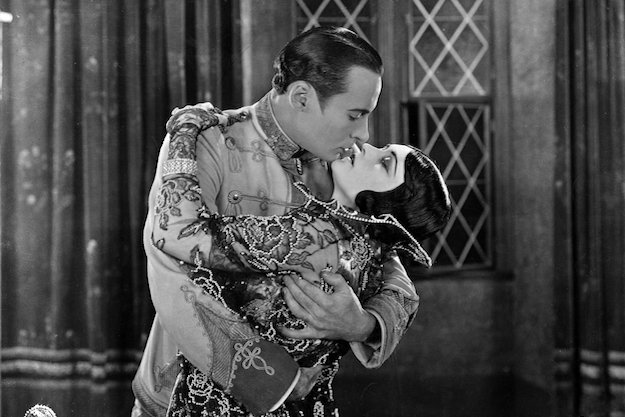
Forbidden Paradise
An even bigger French epic, Jacques Feyder’s three-hour L’Atlantide (1921), was shown in a new color-tinted restoration by Lobster Films. Shot on location in the Algerian desert and on art nouveau, orientalist-fantasia sets, the story recounts the fate of two French Foreign Legion officers who stumble upon the remnants of Atlantis, a hidden oasis with a palace ruled by the femme fatale Queen Antinéa (Stacia Napierkowska, doing her best Theda Bara impression). On arrival, the officers are shown a red marble room ringed with 25 sarcophagi—each holding the remains of one of Antinéa’s “husbands,” men like themselves whom she captured and seduced, and who succumbed to suicide, madness, or drug addiction when they were cast aside. One of the officers, the pious Captain Morhange (Jean Angelo) resists the queen’s wiles, leading to jealousy, betrayal, and murder. There is surprisingly little action in this adventure, but the film’s trance-like mood of sensuous lassitude and hothouse exoticism gradually becomes overwhelming.
Ernst Lubitsch’s Forbidden Paradise (1924) also has magnificent, oversize sets and lavish costumes, romance entangled with political intrigue, and a queen who treats her soldiers as a male harem. But here all is leavened with humor, spiced with Lubitsch’s particular brand of sophisticated smuttiness. Virtually every shot contains a “Lubitsch touch,” some small detail or bit of business that conveys meaning through sly shorthand: a bucket filling with champagne corks, a footstool put to amorous use by the petite queen. Pola Negri claimed she suggested the source material, a book about Catherine the Great (though in Lubitsch’s version her empire becomes a small Ruritanian backwater), and she dominates the film with an expressiveness and comic flair at once subtle and boldly calligraphic. If she perfectly matches Lubitsch’s style, Adolphe Menjou, as her loyal chief minister, embodies his spirit—urbane, tolerant, all-knowing, amused, with perhaps the faintest whiff of melancholy. In the end, when the queen has lost her strapping young lover (Rod La Roque), perhaps the one man she really cared for, the framing of her tiny figure in the cavernous, grandiose spaces of the palace adds a bittersweet tinge to the confection. Lubitsch’s style lost nothing with the addition of sound, but seeing Forbidden Paradise (newly and beautifully restored by the Museum of Modern Art and the Film Foundation) among so many other silent films brought home how little he needed it. Much of the pleasure of silent movies comes from the way they communicate ideas and emotions. They have to work harder, and so does their audience, so when artists like Lubitsch or Buster Keaton make it feel effortless, the effect can only be called magic.
Imogen Sara Smith is the author of In Lonely Places: Film Noir Beyond the City and Buster Keaton: The Persistence of Comedy, and has written for The Criterion Collection and elsewhere. Phantom Light is her regular column for Film Comment.



